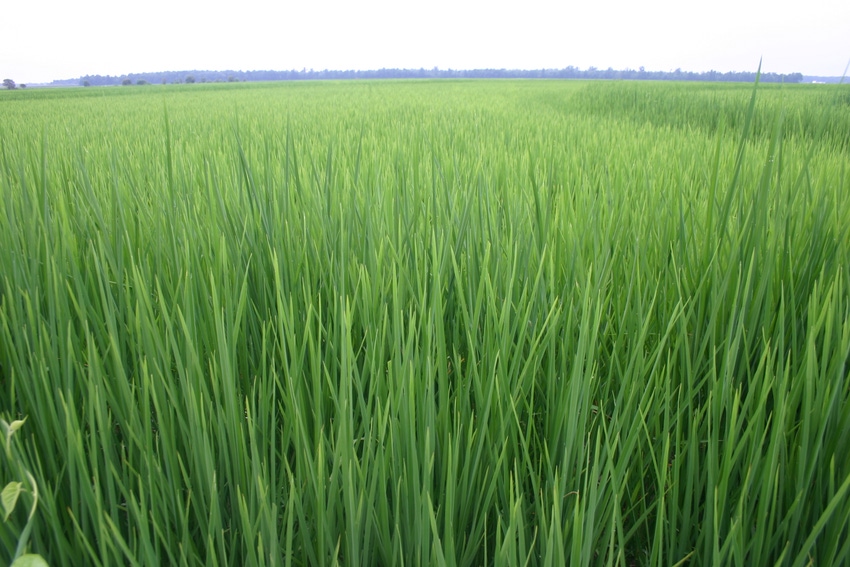
To put it mildly, 2018 was not an easy year for weed control in rice.
And “barnyardgrass was the uncontested winner of 2018,” says Tom Barber, Arkansas Extension weed specialist. His prediction? In the future, 2018 will be referenced as the year “several things went wrong. For most rice producers, barnyardgrass control is probably at the top of that list.
“To say the least, the weather conditions for the 2018 growing season could be closely related to a ride on the Time Traveler roller coaster at Silver Dollar City. Wet conditions and frequent rains early, ended abruptly in May. May and June felt much more like July or August in ‘normal’ years.”
For the last several years, Arkansas rice weed control recommendations “have included residual herbicides, especially Command at planting mixed with either Facet, Sharpen, or League. For the most part I believe that 98 percent of our acres did receive at least Command at planting.”
And growers have been listening.
“Many have followed our call to apply another residual herbicide at spiking or one/two-leaf in an attempt to overlap the residual barrier to reduce or prevent more flushes of barnyardgrass, which is usually easier than killing it once it comes up,” says Barber.
“This is a great game plan and for those that flushed like we did in our plots or those lucky enough to receive some timely rains, the program worked great and those were the cleaner fields at flooding. The unfortunate part was the activating rains were scattered and many did not flush, most of these fields had revenge applications for barnyardgrass all summer long with mixed results depending on products used. Needless to say, an average weed control program for many growers reached or exceeded $150 per acre.”
For good reason, Loyant herbicide has been the topic of many meetings prior to this season. “Our work over the last three years has shown promising results with barnyardgrass control in a ‘program’ approach that includes multiple residuals. The problem this year, again, was that residuals were applied but not activated.
“In many cases when Loyant was applied, grass populations were heavy and larger than we feel comfortable with control with one application of anything. However, there were many production fields — and in some of our research plots — where Loyant simply didn’t work on barnyardgrass this year. In fact, there were some fields I walked in June where the hybrid rice appeared to be more injured than the barnyardgrass plants.”
So what happened? Why was this year so different?
“To be honest, I’m not sure we know all the answers. Again, we observed things with Loyant this year we have not seen the past three. Maybe it was environmental.
“One observation that seemed to be consistent through my discussions with rice consultants was that applications made by air resulted in somewhat better barnyardgrass control than ground applications. That could indicate that available moisture at time of application may be critical for grass control with Loyant.
“Additionally, we know that time until flooding can also have a direct effect on Loyant efficacy on grass. The positive for Loyant in 2018 was the excellent control of broadleaves, especially pigweed and annual sedge control, including ALS-resistant sedge.”
Regardless, Barber believes the product “continues to have a fit in our programs for that reason and on furrow-irrigated rice where broadleaves, especially pigweed, can be a bigger problem.”
What about Loyant going forward?
“We know Loyant works well on annual sedge, broadleaves and some aquatics; the biggest questions moving forward circle around crop injury and grass control. We plan on conducting more extensive work on hybrid and medium-grain varieties to determine what Loyant rate, environmental conditions, time to flood and growth stage play on injury that was observed this season. For now, we’re hesitant to recommend Loyant on hybrid or medium-grain rice for 2019.
“The lack of or highly variable barnyardgrass control in many fields this year was concerning and we are going to investigate this further, looking at moisture present at time of application, flood timing and grass size.”
The off-target issue with Loyant on soybeans this year “was also concerning and frankly reduced the total amount of Loyant applied at least out of an airplane. Many aerial applicators refused to spray after numerous off-target complaints. Some were saying that Loyant is volatile like dicamba, but once applications switch to ground rigs, off-target movement was reduced. Additionally, results from research we conducted in 2018 indicate the off-target issues with Loyant were due to physical drift or spraying into an inversion, not volatility.”
Going into 2019, what are the topics barber plans to hit at winter meetings?
“On rice, the main thing we’ll preach is overlapping residuals. Maybe producers can do a Command or Facet pre, follow that with a late-pre or early-post of Prowl/Bolero or Prowl by itself. Then, watch the grass emergence closely. We can’t continue to let it grow and then hope we catch it pre-flood.
“Ricestar and Regiment applications resulted in good pre-flood control this year. Where resistance is not as widespread, Facet plus propanil or Newpath continues to work well. Residuals are going to be key this year especially if furrow-irrigated acres are increasing at the rate that is rumored.”
Barnyardgrass resistance continues to be a major concern across this state. “We have received near 200 samples from suspected cases this year. Our continuous rice acres continue to cause the greatest threat for three- and four-way resistance in barnyardgrass. We really need to rotate these fields to beans or fallow to help reduce the barnyardgrass seedbed populations.”
Also good news: Provisia rice weed control programs were “very effective for the most part on both barnyardgrass and off-types/red rice. This system will continue to fit well on those acres where no other options are available.”
Barber anticipates “acres of Provisia will increase due to the success of the grass control on those problem fields.”
About the Author(s)
You May Also Like




